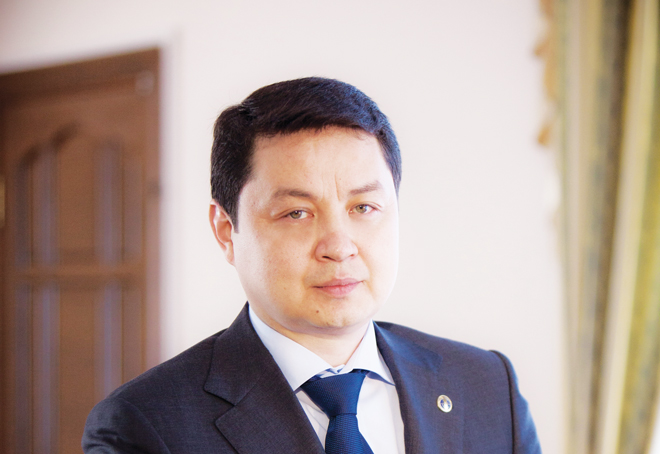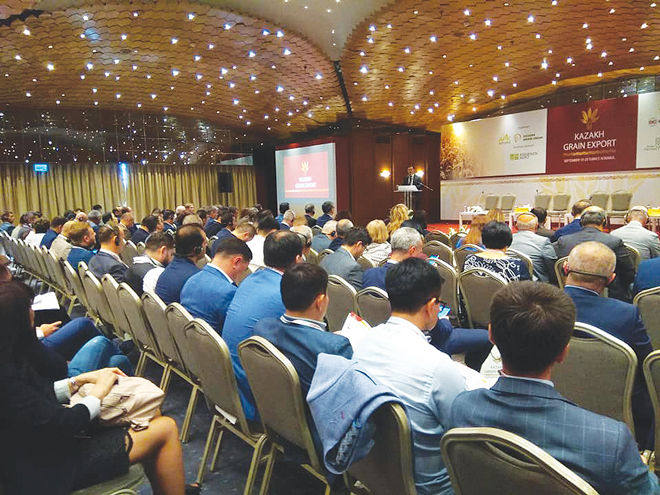Nurlan Ospanov, Chairman of the Kazakh Grain Union: “Kazakhstani grain exporters are constantly in search of markets and optimal routes for delivering products to consumers. We are also working to improve the quality of exported products and establish a fair price for our products. The Chinese market is very attractive to us b ecause it is a huge solvent market and relatively low transportation costs associated with close logistics.The volume of wheat supplied to China today is approximately 5.5% of the total export of Kazakhstan wheat. According to our estimates, over the next 5 years, it will be 15-20% of our total wheat export.”

Interview: Namık Kemal Parlak
Kazakhstan has a large agricultural sector featuring livestock and grain. The country, with its large and fertile lands, has great potential in agriculture. It is a major player in the grain and flour market. Kazakhstan is one of the top 10 grain exporters in the world, exporting to over 70 countries. It has been trying to increase its wheat export and find new markets. In that regard, the Kazakh Grain Union organized an international grain conference in Istanbul, Turkey, on September 19-20. The industry leaders from Kazakhstan and the world discussed global trends of the grain market at ‘KazakhGrainExport 2019’ conference. Nurlan Ospanov, Chairman of the Kazakh Grain Union, gave an exclusive interview to Miller Magazine at the sideline of the event. We talked on the grain policy of Kazakhstan, dynamics in the grain sector and new export markets for Kazakh grain and also challenges that Kazakh grain exporters face.
Here are Mr. Nurlan Ospanov’s answers to our questions:
Mr. Ospanov could you please give some information about Kazakh Grain Union? What is the mission of your Union?
Association of legal entities “Kazakh Grain Union” was created on November 2, 1995, in the form of a non-profit organization. The purpose of the Union is to unite enterprises and organizations of the grain market to coordinate their activities, to represent and protect common interests. The mission of the Union consists in creating favorable conditions for the sustainable development of the grain market of Kazakhstan.
Currently, the Union unites 105 leading enterprises of the grain market of Kazakhstan, which are engaged in the production, storage and export of grain, the supply of plant protection products and agricultural machinery, the provision of surveyor and transport and logistics services.
You organized a grain export conference in Istanbul between 19-20 September. What was the aim of the conference? What kind of feedback did you receive regarding the conference?
Kazakh Grain Union participates in the organization of annual conferences KAZGRAIN and KAZOIL. The main purpose of these events is the promotion of Kazakh grain, leguminous and oilseed products to world markets. Earlier we held such events in Kazakhstan but this year we decided to organize a conference in Istanbul. I want to express my gratitude to the Ambassador of the Republic of Kazakhstan in the Republic of Turkey and the General Manager of the Turkish Grain Board (TMO) for support in conducting and participating in our event. At the conference, we discussed current trends in global and local markets, as well as prospects for trade in Kazakh products.
We also wanted to provide an opportunity for Kazakh companies to meet with their existing partners from Turkey, Italy, Russia and other countries, as well as meet new ones to expand the circle of their potential business partners. We managed to do it. During the conference, agreements were reached on the supply of durum wheat and lentils from Kazakhstan, as well as interest in transactions with soft wheat, peas, rape and flax.
Summing up, I want to thank the participants of the Conference for the high appreciation of our event and the speakers for interesting presentations. I hope that our conference will be held in Istanbul in the future.
Following the government directive, Kazakhstan has been reducing wheat planted area. Which crops are replacing wheat? What kind of changes have you experienced in the grain industry in recent years?
As you know, in Kazakhstan for many years only wheat, barley and sunflower were produced. But in the past few years, the situation has changed markedly. Thus, due to the reduction in wheat sowing, the production of such crops as flax and rape seeds, barley and lentils has significantly increased. For example, the sown area for flax seeds increased from 556 thousand hectares in 2014 to 1.287 million hectares in 2019, that is more than 2.3 times. Thus, Kazakhstan has become a major producer and exporter of flax seeds. The volume of production and export of Kazakh flax in the season 2018/19 amounted to 25% and 35% of the volume of global production and export, respectively.
The share of Kazakh lentils in global production was 2.2%. With this indicator, Kazakhstan entered the 10 largest lentil producers in the world. At the same time, lentils in Kazakhstan are still considered as a crop that participates in crop rotation, and not as one of the main export-oriented crops. Therefore, in the presence of steady demand and fair prices, Kazakh producers can significantly increase the production and export of lentils, including to Turkey. In general, it is important to note that Kazakhstan carries out a lot of work to produce crops that are in demand on global markets, as well as to search and optimize their delivery routes to consumers.

Kazakhstan is one of the most important grain producers and exporters in the world. It has been trying to increase its wheat export and find new markets. And China is a huge potential market for Kazakh producers. Grain supplies from Kazakhstan to China have increased in the last three years. How will the Kazakh-China grain trade develop? What are your expectations? Where will be other opportunities and regions for Kazakh exports?
Indeed, the Chinese market is very attractive to us. Because it is a huge solvent market and relatively low transportation costs associated with close logistics.
The volume of wheat supplied to China today is approximately 5.5% of the total export of Kazakhstan wheat. According to our estimates, over the next 5 years, the share of wheat exports to China will be 15-20% of the total export of Kazakhstan wheat. The main markets for our wheat are Uzbekistan, Tajikistan, Kyrgyzstan, Afghanistan, as well as the border regions of Russia. For our wheat with high protein content, we see such potential markets as Russia, Turkey, China, European countries.
Logistics problems are limiting the Kazakh grain trade. Kazakhstan has trouble reaching international markets due to the lack of direct access to ports. Could you tell us recent investment plans and projects to solve logistics problems?
Logistic problems will be solved in the directions of the delivery of Kazakhs products to Turkey and China. For example, in addition to the existing routes through the ports of the Black and Azov Seas, we have plans to develop multi-modal supplies along the route to Turkish Kars region through the territory of Azerbaijan and Georgia. Here it is necessary to create a modern grain transshipment infrastructure and agree on acceptable transit railway tariffs.
In the direction of China, the project for the development of the International Center for Border Trade, located on the border of Kazakhstan and China, has huge potential for agricultural trade with China in agricultural products, both in the form of raw materials and in the form of products made from raw materials on the territory of this Center.
What are other major challenges for Kazakh grain exporters today?
Kazakhstani exporters are constantly in search of markets and optimal routes for delivering products to consumers. This is not an easy task, given the geographical location of our country. We are also working to improve the quality of exported products and establish a fair price for our products. We understand that our partners are interested in stable quality and compliance with the plan and delivery time of products, so the most important task for us is to solve current problems, which will allow us to comply with the requirements of our partners.
Do you think there is a quality problem regarding Kazakh wheat? Is Kazakhstan wheat standard consistent with international standards?
The quality problem of Kazakh wheat can be considered from several sides. For example, small farms do not always have the ability to use modern varieties or high-quality wheat seeds. But professional grain traders who buy wheat from both small farmers and large wheat producers can always form an export batch that meets the requirements of importing buyers. Therefore, this problem can be solved by having a professional grain trader in partners.
Another problem is inexperienced or unscrupulous grain traders, elevators and surveyors, who sometimes can export wheat that does not meet the requirements of the buyer-importer. To solve this problem, we recommend that importers deal with professional grain traders, most of whom are members of the Kazakh Grain Union.
Regarding quality standards, I want to note that Kazakhstan has a national quality standard for wheat. Methods for determining the quality and some of their indicators differ from international standards. At the same time, Kazakh standards for individual quality indicators are more stringent than international ones. The Kazakh Grain Union takes an active part in the work of the State Committee for Technical Regulation regarding the harmonization of national and international standards. As a result of this work, part of the quality indicators in the national standard is now determined by the methods established by ISO.